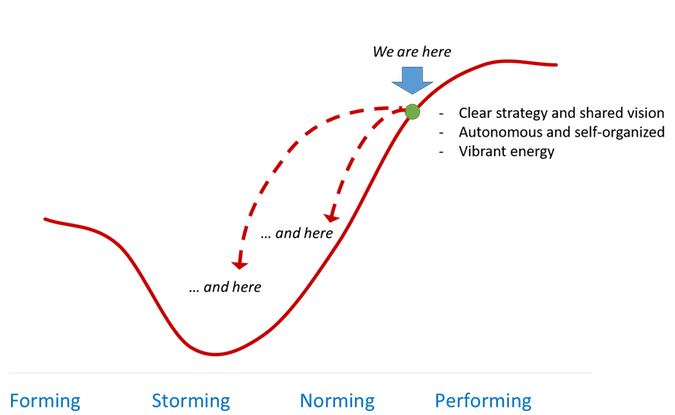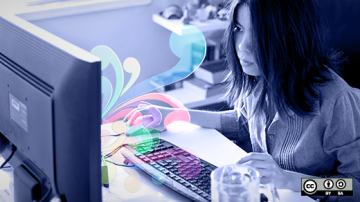I am one of the agents of chaos who passionately argued the importance of removing barriers and recognizing that people are the core of a healthy DevOps mindset. Fast-forward to the COVID-19 pandemic, in which collocated teams were forced to disperse overnight into self-isolating distributed entities, relying on technology to bring us all back together in a virtual world.
As I write this, it is day 56 of self-isolation, and I am working remotely from home. Everyone is reflecting and mulling over tons of questions, such as:
- What will the future bring?
- Will we ever return to what we understood as normality?
- What effect does this traumatic pandemic have on a healthy DevOps mindset?
OK, that last question is probably not on everyone's list of big rock questions, but it is top of my mind—hence this article. Let's explore.
The challenge
A healthy DevOps mindset navigates through different paths of continuous improvement wherein disruption, discipline, and guardrails are the norm. What no one anticipated is the radical disruption we are all experiencing due to the pandemic, and the impact it has on our DevOps and personal mindset, our workflows, and the ceremonies of kanban and agile teams.
You may recall Tuckman's theory of group development, which outlines how teams grow into productive high-performers in stages. As expected, most, if not all, agile teams that switched from collocated to remote setup will slide back from the norming and performing stages to the storming stage, as shown in Figure 1.

Figure 1—Back to storming, adapted from Tuckman's Stages of Group Development
Embrace change and do not panic. Sliding back to storming is normal, and an opportunity to embrace the challenges.
Here are ten recommendations for a healthy DevOps mindset as we evolve the collaboration and delivery model of our organizations during (and after) the pandemic.
1. Build new interaction points
Human interaction is foundational to DevOps. A key theme of all of the improvements that can be made remotely will likely be the invention of new ways to stay in touch from a distance.
You can continue to build stable relationships with your peers, colleagues, workers, and users using virtual communication to host a community of practice, discussions, demonstrations, and meetup events. To replace those invaluable in-person hallway discussions, my team is contributing to monthly virtual meetups and hosting fortnightly webcasts to discuss topics of interest, such as our new continuous delivery pipelines. The now-virtual ceremonies allow us to connect, maintain a supportive presence, create transparency, and communicate intent, which is critical to showing loyalty and confronting today's surreal and trying times.
2. Keep gathering feedback from stakeholders
Gathering feedback through observation and collaboration in the place where users are working and creating value is an invaluable practice, known as the Gemba walk. Unfortunately, the current social distancing guidelines rule out all in-person interactions.
Focusing on our stakeholders and their feedback rather than simply changing for the sake of change is a recipe for success during this time. To adjust our processes and complement with the right technologies and tools requires arduous collaboration between development, operations, and security stakeholders. Schedule more virtual communications to connect all stakeholders, and review the evidence and revise workflows together. We use a mix of meetups, webcasts, ad-hoc virtual chats, and electronic polls to replace our personal observation of working environments, to listen, and to understand what is important to our colleagues.
3. Fight the urge to build new silos
On short notice, everyone left the familiar setup in our home office, where many people worked together in the same location. Instead of teamwork and collaboration, which is vital for both agile and DevOps, we are now isolating ourselves behind the Internet router. Instead of breaking down silos, we are essentially creating a macrocosm of virtual silos.
Inspire and share collaboratively instead of becoming a hero or creating another silo. This is probably the most challenging DevOps core value to nurture during the pandemic.
How do we address the risk of silos? You guessed it—we scheduled a mix of virtual daily heartbeat sync-ups, a series of virtual ad-hoc Learn Cafés, Dojos, and Community of Practice (CoP) discussions, and use social networks such as Twitter and WhatsApp. Integrating social collaboration and activities is important to maintain connections that go beyond the business connections and help to foster team and cross-team solidarity.
4. Let metrics guide cross-organization improvement
Continuous innovation, learning, and collaborating on an idea, concept, assumption, or feedback is more challenging when working in isolation. Instead, use the opportunity to focus on understanding and optimizing your workflows, and if available, analyze your telemetry. It is amazing how a new environment, a few hours of solitude, and a fresh perspective can fuel innovation and collaboration.
Open your mind, explore the unfamiliar, and measure performance across the organization, not just in a line of business.
5. Invest in a culture of learning
Learning does not happen automatically, so you should ensure that you include dedicated learning opportunities in your new routine. Continuously review your processes, automation (or lack thereof), products, and documentation—it is an opportunity to ensure that anyone can operate without having to have a face-to-face discussion to gather the missing links.
Be positive when you can, and honest when you cannot, but always smile during your virtual collaboration sessions. Your honesty, humility, and enthusiasm will be felt by others, and inspire your colleagues and stakeholders to explore new frontiers through a fresh set of eyes and embrace a growth mindset.
6. Set up an effective workspace
I have the good fortune to already have set up an ergonomic and effective workspace. While many of us did not start working from home with all the essential features, we are at the point in this pandemic where its time to invest—continuing to hunker down in the kitchen area is a recipe for disaster!
We need to find a designated work area, preferably with a door to reduce interruptions and background noise during virtual conference calls. Investing in dual and large monitors, a quality headset, camera, and accessible whiteboard are assets that will contribute towards an effective workspace. If your personal budget is tight, it does not hurt to ask an employer how much you could expense for your workspace.

7. Create a routine
I approach my remote workday as structured as any other workday—do not succumb to the temptation to check your email after smashing your alarm clock! Go through the same hygiene and breakfast routine, dress for work, check in with your team, and remember to take regular breaks to create an accustomed rhythm. Your own discipline must be the substitute for the old built-in routine. Be vigilant to plan your day, clarify expectations, and focus on your highest priorities.

8. Connect, connect, and connect
As highlighted by the very first item in this list, the core value of our DevOps mindset at home is collaboration. This means we must listen, talk, create transparency, and extend trust. Confer with your manager to clarify expectations and stay in touch with your team and stakeholders via emails, chats, video conferencing, and phone. Ensure you are present and focused during video conference calls. If available, keep your camera on to ensure that visual cues and expressions are not lost, and most importantly, show kindness and demonstrate respect.

9. Focus
The best organizations in the world understand that this working environment is not normal and that family is most important. That acknowledged, it is quite nice to have some time to feel productive in our work.
The most challenging aspect of remote work is distractions around the house. Headphones, earplugs, and a closed-door can help you focus and remind family members that you are in a video conference or need some time to concentrate.

10. Do not forget to stay healthy
We have all lost our routines right now, but my hope is to maintain a remote workday that is no different from a normal office day. Create a routine; include a variety of breaks, stretches, snacks, or a sip of your favourite brew. Working in isolation introduces unfamiliar anxiety and stress—a 15-minute or longer walk will do wonders for your soul and health!

Be open and be well
We are on a surreal but exciting journey of change and innovation. We will continue to question our social norms and cultures, rely on the virtual world and collaboration products more than ever, and evolve to the next era of digital transformations.
Do not fight evolution or innovation, embrace reality, and, most importantly, enjoy the opportunity to self-reflect and the tranquility of a less busy and polluted planet.

Tranquil sunset over Westham Island, BC










Comments are closed.